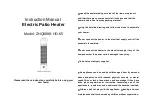
16
To avoid water damage or scalding due to relief valve operation:
•
Discharge line must be connected to relief valve outlet and run to a safe place of disposal.
Terminate the discharge line in a manner that will prevent possibility of severe burns or property
damage should the relief valve discharge.
•
Discharge line must be as short as possible and the same size as the valve discharge connection
throughout its entire length.
•
Discharge line must pitch downward from the valve and terminate at least 6” above the floor
drain, making discharge clearly visible.
•
The discharge line shall terminate plain, not threaded, with a material serviceable for
temperatures of 375
o
F or greater.
•
Do not pipe discharge to any location where freezing could occur.
•
No shutoff valve may be installed between the relief valve and heater or in the discharge line. Do
not plug or place any obstruction in the discharge line.
•
Test the operation of the relief valve after filling and pressurizing the system by lifting the lever.
Make sure the valve discharges freely. If the valve fails to operate correctly, immediately replace
with a new properly rated relief valve.
•
Test T&P valve at least once annually to ensure the waterway is clear. If valve does not operate,
turn the heater “off”
and call a plumber immediately.
•
Take care whenever operating relief valve to avoid scalding injury or property damage.
FAILURE TO COMPLY WITH THE ABOVE GUIDELINES COULD RESULT IN FAILURE OF RELIEF
VALVE OPERATION, RESULTING IN POSSIBILITY OF SUBSTANTIAL PROPERTY DAMAGE,
SEVERE PERSONAL INJURY, OR DEATH.
Do not, under any circumstances, thread a cap or plug into the relief valve! Explosion, serious injury or
death may result. Relief valve piping must be directed to the floor or an open drain, but not connected.
There must be a 6" space between the outlet of relief valve piping and drain or floor. Do not hook up to
drain system directly without an air space. The relief valve must be checked periodically for proper
operation.
B. DOMESTIC HOT WATER EXPANSION TANK
A potable hot water expansion tank is required to offset the expansion as the water is heated. In most city
plumbing systems, the water meter has a no return or back flow device built into the system to prevent
water flowing back into city mains. Some local codes require back flow preventers on all incoming water
supplies. The hot water expansion tank must be listed for potable water use. The expansion tank should
be located on the cold inlet piping close to the water heater.
The expansion tank must be suitable for hot potable water.
Never use dielectric unions or galvanized steel fittings on any domestic water or auxiliary
connections. Use only copper or brass fittings. Thread sealant must be used on all connections.
Содержание Versa Hydro PHE130-119
Страница 23: ...23 Figure 5 Figure 6 ...
Страница 24: ...24 Figure 7 ...
Страница 25: ...25 F HYDRONIC PIPING Figure 8 ...
Страница 26: ...26 Figure 9 ...
Страница 27: ...27 Figure 10 ...
Страница 28: ...28 Figure 11 ...
Страница 29: ...29 Figure 12 ...
Страница 32: ...32 F INTERNAL WIRING Figure 14 Internal connection diagram ...
Страница 38: ...38 Figure 17 ...
Страница 48: ...48 Figure 25 ...
Страница 76: ...76 Figure 29 ...
Страница 77: ...77 Figure 30 ...
Страница 78: ...78 Figure 31 LP 314 G ...
Страница 79: ...79 Figure 32 ...
Страница 81: ...81 ...
Страница 82: ...82 ...
Страница 83: ...83 MAINTENANCE NOTES ...
















































